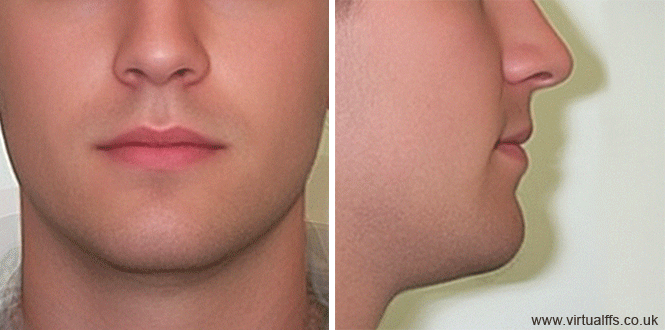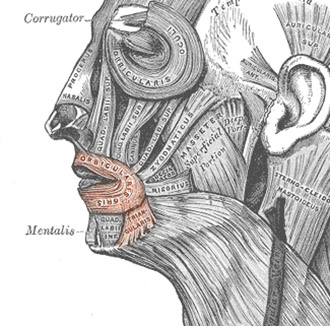Lips
Gender Differences:
The distance between the top lip and the base of the nose tends to be shorter in women, and when the mouth is open and relaxed, women tend to show 2 – 4 mm of their upper teeth while men tend not to show any upper teeth at all.
Female lips are also, on average, a little fuller than male lips. You can see this in the profile pictures below - the female lips bulge forwards a little more than the male lips – in other words they are slightly more “pouty”.
Feminine lower lips also appear to have a slightly different shape – they are a little more “V” shaped while masculine lower lips have more of a “U” shape. I suspect this is not a very significant factor in gender recognition.
Here is an animation created from averaged male and female faces showing the lip differences.

Surgical Options to
Lift the Upper Lip:
You can shorten the lip-to-nose distance with a procedure called a "lip lift". There are 3 types of lip lift procedure:
1. Bullhorn Lip Lift:
Also called the "subnasal lift". This is the most common lip lift type in FFS and involves making an incision at the base of the nose,
removing a section of skin, then closing the gap you have created to
lift the lip. The downside of this procedure is that it always leaves a
visible scar at the base of the nose. See "questions" section below for more
on this.
The incision for a bullhorn lip lift is only as wide as the nose so it can only lift about the middle third of the lip. This is not generally a problem unless you have very downward-pointing corners to your mouth. If you do have downturned corners, then a lip lift can emphasise it and you then need to find a balance between lifting enough to feminise your mouth, but not lifting so much that you over-emphasise the downturned corners.
2. Gull Wing Lip Lift:
Also called a "vermilion advancement". This is where a strip of skin is removed from along the top edge of the lip and the gap is stitched shut lifting the lip.
I strongly advise against this procedure because the scar
is long and is in a very noticeable place. If the scar is also very clear,
the effect can be very disfiguring.
3. Corner Lift:
This is for people who have downturned corners to their mouths and involves
taking out sections of skin from above the corners of the top lip to lift
them. It has the same scarring risk as the gull wing lift except that
it leaves 2 shorter scars rather than one long one. I don't recommend it.
Surgical Options for
Lip Filling:
There are 4 approaches to making the lips fuller:
1. Temporary Injectable Fillers:
These include hyaluronic acid which occurs naturally in the body and is marketed under names like “Restylane”, “Perlane” and “Juvaderm”. The length of time it lasts varies from person to person and from brand to brand but typically it lasts from 4 to 12 months (some brands are longer lasting because they contain more of the hyaluronic acid).
2. Permanent Injectable Fillers:
These include products like Aquamid gel and Artecoll. Some of them (including Artecoll) contain tiny plastic spheres and there is a risk that these can cause lumps to form (granulomas). The
lumps are not dangerous but they are difficult to remove. Permanent fillers
tend to feel more solid.
3. Patient's Own Tissue:
You can have fat from another part of the body injected into the
lips.
This is called a "fat transfer" or sometimes a "fat graft". Using your own fat means that there is no risk of rejection or allergic reaction.
However, there is some unpredictability involved
with fat transfers because some of the fat is reabsorbed by the body. The
amount that remains varies from person to person and is quite unpredictable -
it can be anywhere from about 30% to about 80%. So you will need to top up as necessary a few months later.
That way, you gradually build up the permanent layer until what remains is the amount
you need.
Other options include using dermis (one of the deeper skin layers) or fascia (a tissue that covers muscle). These are removed as strips and threaded though the lips from one end to the other. They last well but may thin a little with age. Using dermis or fascia will produce more swelling than injectable procedures.
4. Artificial Implants:
Thin strips of a soft plastic material called Gore-Tex (Advanta is one brand) can be threaded through the lips from one end to the other. There are the usual surgery infection risks and patients can feel the implant under the skin to some degree though many say this is not a problem
for them.
Some Questions:
How visible is a lip lift scar?
That depends on several things. In some people, there is a clear crease
where the nose meets the upper lip and you can hide the lip lift scar in
that crease to some extent. But in some other people, this area is very open
and there is no crease to hide the scar in. For them, the scar is likely
to be more visible.
Then there is the question of how bad the actual scar will be. The problem with scars is that people scar differently to each other, and the same person can scar differently on different occasions. The surgeon can certainly minimise the risk of a very visible scar by doing careful work with the right kind of suturing, but even if their work is perfect, your body can still make a very visible scar.
Some people are perfectionists and can be very distressed by even a small scar, whilst other people are very relaxed about it and are happy to just put a bit of make-up on it to help hide it. However, a lip lift is a relatively quick and easy procedure so if you are not sure, you can delay the procedure and do it separately from your main FFS procedures under local anaesthetic when you have reached a firm decision.
Is it possible to hide the lip
lift incision inside the nose?
Technically yes, however, this will tend to look unnatural because you
will lose the lower rim of the nostril and you are also replacing the skin
in that area with a different type of skin from lower down.
Will a lip lift expose the red of my
lip more?
Maybe a little, but it's a relatively subtle effect.
Will the lip lift drop after a
while?
Some people find that the lip drops to some extent after a while and it is
possible that you will need a second lip lift in the future if it drops
too far.
How far should you lift the
lip?
In both males and females, the opening of the mouth is, on average, just under a third of the distance between the base of the nose and the base of the chin. I call this the "Nolichi rule" and you can read more about it in part 5 of my thesis.
It means that you need to consider how the height of the chin balances with the lip-to-nose distance. If you shorten the chin, you can make the lip-to-nose distance seem longer by comparison and conversely, if you shorten the lip to nose distance, you can make the chin look proportionately taller, so these features need to be considered together.
How does lip filling work with
lip lifting?
lip filling tends to bring the upper lip down a little, so if you have had
a lip lift to expose more of your upper teeth, then you will cover them up
again to some degree by filling the upper lip. This means that you gain a
little femininity with the fullness but lose some with the tooth exposure.
That doesn't mean the 2 procedures should never go together - it just
means you need to consider how they interact. For example, if you have
lots of tooth show, you might still have plenty of tooth exposure even
with lip filling, but if even a strong lip lift has only given you
slight tooth exposure, then you need to be ready to lose that again if you
fill the lips.
How far can I go with lip
filling?
If you want a natural result, then lip filling should limited, and trying to
make thin lips very full can give you an unnatural result that is commonly
called a “trout pout” or “duckbill”. There is always a risk that lip
filling will not be completely symmetrical and the more filler you add,
the greater the risk of asymmetry.
The Muscle Moustache:
There are muscles that sit in the same area as a moustache (the obicularis oris and the triangularis muscles). In some males these can be quite prominent and I call this a "muscle moustache". It is also emphasised by hollow cheeks. Here’s a diagram of the muscles highlighted in brown:

This is greatly improved by hormones and beard removal - the hormones reduce the muscle mass as well as filling the cheeks to bring them up to the level of the muscle moustache so that there is not so much contrast between the two areas, and hair removal simply reduces bulk in this area due to the large density of hairs removed.